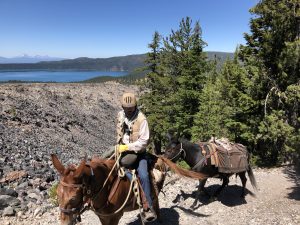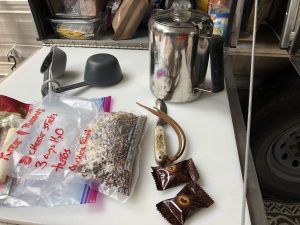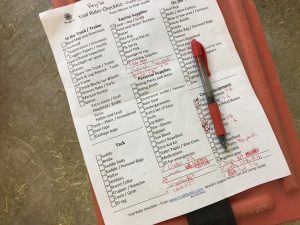From the pages of the Northwest Horse Source magazine
Most years I spend well over 30 days of summer horse packing in remote backcountry areas, as well as numerous trailhead horse camping trips. These adventures generally run from three to fourteen days and are scattered across the Pacific Northwest, with frequent visits to the Rocky Mountain range.
To make these excursions happen in an effective manner, and to minimize mistakes, over the years I’ve developed a planning process that works for any trip and that can be used by any horse camper, or aspiring horse camper.
I believe that successful trips are planned, not improvised. Certainly, you can wing-it a time or two and maybe be successful. But your odds of success vastly increase if you’re willing to do some basic planning beforehand.
How to Plan a Horse Camping Trip
1 – Outline Your Trip’s Goals
I use the 5 W’s of data gathering for this step.
What are the 5 W’s?
Who – What – When – Where – Why
 These general questions are a good starting point for trip planning. You don’t need definitive answers to every question immediately, but you’ll find that answering them is a good exercise to begin narrowing your options.
These general questions are a good starting point for trip planning. You don’t need definitive answers to every question immediately, but you’ll find that answering them is a good exercise to begin narrowing your options.
Start by asking where you want to go, when will you be going, what kind of trip it will be, and who might be going. Then use www.TrailMeister.com to help narrow your choices and find the land manager to lookup rules and regulations.
Next add more specifics. What length of time will you be traveling? What specific trails, routes, landmarks, or campsites do you want to visit? How many miles do you intend to cover?
Finally, consider the logistics of the trip.
- Do you need permits, coggins tests, brand inspections, are there special feed requirements? If so, how, when, and where will you get them?
- What route will you take to the trailhead and back? What are road conditions like and can your trailer accommodate them?
- Are there any noteworthy land-use regulations or requirements you need to be aware of? Are there typically fire or bear restrictions in place during the time you plan your trip?
I put all of these details into a trip planning document that can be shared with anyone that I’m going with as well as my emergency contacts before I leave.
2 – Determine What Should be Expected
 Once you have a reasonably defined trip plan, research the conditions you will likely encounter, so that you can prepare properly, mitigate risks, and rule out baseless what-if scenarios. Consider the Boy Scout motto: “Be Prepared.”
Once you have a reasonably defined trip plan, research the conditions you will likely encounter, so that you can prepare properly, mitigate risks, and rule out baseless what-if scenarios. Consider the Boy Scout motto: “Be Prepared.”
I’m interested in anything that will influence my equipment and supplies. I look into climate, length of day, trail footing, wildlife and insects, feed for the horses, water availability, and potential natural hazards like lingering snowfields, river fords, or lightning. Add this information to your trip planning document.
3 – Decide What to Take
 For beginner horse campers, the task of equipment selection is usually the most time-consuming, certainly the most expensive, and unfortunately also the most frustrating. Beyond the vagaries of camping equipment there’s a myriad of equine equipment that promises to “do-it-all” but in reality rarely delivers.
For beginner horse campers, the task of equipment selection is usually the most time-consuming, certainly the most expensive, and unfortunately also the most frustrating. Beyond the vagaries of camping equipment there’s a myriad of equine equipment that promises to “do-it-all” but in reality rarely delivers.
To make this process easier, I designed a Trail Rider Checklist that to help cut through some of the noise. https://www.trailmeister.com/trail-rider-check-list/
Talk with people that have been where you plan on going so that you can get trip-specific advice. If you don’t have an immediate contact who really knows their stuff, I suggest contacting a local Backcountry Horsemen chapter or other trail advocacy group.
Tailor your equipment to your itinerary and expected conditions.
4 – Plan The Meals
 What are you and your animals going to eat?
What are you and your animals going to eat?
Rather than ask my animals to carry more food than we need, and to carry it all back home at the end of a trip I create a detailed menu for myself and for my animals, I try as much as possible to determine what type of graze I can expect to encounter. If you’re trailhead camping this becomes much easier; you can simply haul feed for the ponies. Be sure research feed requirements beforehand. If back country camping, be willing adjust your route and/or destination to allow for adequate grazing.
5 – Collect Navigational Resources
 When I first started trail riding I used whatever resources were available and seemed adequate. Usually they were OK. Not great by any means but generally I arrived back at the trailhead before dark.
When I first started trail riding I used whatever resources were available and seemed adequate. Usually they were OK. Not great by any means but generally I arrived back at the trailhead before dark.
When I started riding and camping further afield, I had to create a lot of these materials from scratch. Through this process, I developed a system of maps and resources that I use on trips (https://www.trailmeister.com/guide-to-maps/) that includes large and small scale paper topographic maps, digital maps downloaded to a GPS app, as well as route descriptions and tips.
6 – Gain Skills
 There’s no better way to improve your riding and camping skills than by riding and camping. Unfortunately, not all of us have the time and ability to do that. I certainly don’t have the opportunity to remain on the trails all year long. The next best option is maximize the time that you do have. I do this by scheduling time throughout the week for practicing camp and trail skills. For example I practice packing skills on Blue; my faux mule in the evenings. And most days prior to dinner I try to spend 10-15 minutes with each animal on simple groundwork exercises.
There’s no better way to improve your riding and camping skills than by riding and camping. Unfortunately, not all of us have the time and ability to do that. I certainly don’t have the opportunity to remain on the trails all year long. The next best option is maximize the time that you do have. I do this by scheduling time throughout the week for practicing camp and trail skills. For example I practice packing skills on Blue; my faux mule in the evenings. And most days prior to dinner I try to spend 10-15 minutes with each animal on simple groundwork exercises.
A practice trip can also be quite worthwhile. My first camping trip of EVERY year takes place in the relatively low risk environment of my backyard. These test trips give you an opportunity to use your gear, practice skills, and identify room for improvement before you undertake a more committed journey.
Focus on replicating the elements of a real trip:
- Setting up a highline – https://www.trailmeister.com/hold-your-horses-highline-revamp/
- Leading a Pack Animal – https://www.trailmeister.com/why-everyone-should-be-able-to-pony-their-horse/
- Camp Cooking – https://www.trailmeister.com/f-is-for-food/
You can also read and watch skill tutorials, such as my series on:
- Navigation skills – https://www.trailmeister.com/understanding-your-compass/
- First Aid Skills – https://www.trailmeister.com/your-first-aid-kit/
- Tying Knots – https://www.trailmeister.com/category/knots/
7 – The Final Check
 A few days before your trip, complete any remaining planning tasks. Using your checklist, pack up all your gear, including your maps, resources, and permits. Check a five-day weather forecast, and adjust your gear accordingly. Finally, proofread your trip-planner document (https://www.trailmeister.com/trail-ride-itinerary/), and leave it with your emergency contacts.
A few days before your trip, complete any remaining planning tasks. Using your checklist, pack up all your gear, including your maps, resources, and permits. Check a five-day weather forecast, and adjust your gear accordingly. Finally, proofread your trip-planner document (https://www.trailmeister.com/trail-ride-itinerary/), and leave it with your emergency contacts.
Using these seven steps on How to Plan a Horse Camping Trip will help you refine your skills, elevate your camping experiences, help ensure fabulous camping trips. For more information on, and the largest guide to horse trails in the world, visit www.TrailMeister.com.

TrailMeister is the world’s largest horse trail and camp guide. With all of the info that you need on thousands of horse trails and camps across the US and Canada.

